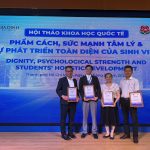In essence, STEAM education is experiential learning that equips preschool children with essential knowledge and skills related to Science, Technology, Engineering, Arts, and Mathematics. These disciplines are integrated and complement each other, helping children gain understanding about the natural and social world, as well as practical skills to create products in their daily lives. STEAM education in preschool is implemented through a thematic and interdisciplinary approach, aiming to:
- Address practical learning tasks through exploratory and hands-on experiences.
- Foster comprehensive and continuous development, catering to the diversity of regions and the children themselves, without altering or disrupting the activities of preschoolers.
This early education approach also aims to instill the 4Cs skills: Creativity, Collaboration, Critical Thinking, and Communication.
2. Some basic issues about children’s games, games following the STEAM approach for preschool children
2.1. Concept of Children’s Play
- Play is a primary activity, especially for children. It is often referred to as the “companion of childhood” and a central aspect of life, reflecting a child’s attitude and emotions towards the surrounding society.
- It is a distinctive activity that significantly influences a child’s psychological development, creating a “zone of proximal development.”
- Play-based learning involves structured activities with specific goals, where the motive is the process of playing itself. It involves completing specific tasks and requires the child’s compliance.
- Children’s play serves as a socially constructive school, where children recreate historical relationships of adults, interpret and define their unique place in the world.
- Role-playing based on themes is a predominant activity in preschool children, effectively serving to nurture certain moral qualities.
2.2. The Role of Children’s Play in Intellectual, Linguistic, and Personality Development of Preschoolers
- Play is indispensable for a child’s health, happiness, self-confidence, and self-awareness.
- It plays a significant role in intellectual development, helping children comprehend the unity and diversity of the world.
- Play fosters creativity and the independent nature of children.
- Psychological development occurs through cultural activities and experiences gained through playful interactions with other children and adults in various social groups.
2.3. Concept of STEAM Approach to Children’s Play
- STEAM play serves both educational and learning purposes.
- Children are required to design, create, operate, and experiment with simple, child-friendly products and items.
- It provides opportunities for children to engage, experience, explore, and undertake playful actions, either individually or collaboratively creating meaningful products. This aids in developing qualities and skills in children.
- These elements are interrelated and yield positive outcomes, bringing joy, fostering positive tendencies, reinforcing, and enriching children’s knowledge.
2.4. Characteristics of game using the STEAM Approach
- Incorporate learning and educational missions.
- Provide children with opportunities to engage in activities, experience exploration, create meaningful products, develop critical thinking, creativity, communication, and teamwork.
- Offer a play environment, toys, and learning materials for carrying out play actions, enabling children to satisfy the need for “smart play, enjoyable learning”.
2.5. Games following the STEAM approach must ensure the STEAM elements.
(1) Science: Games should expand ideas based on children’s understanding, knowledge, and experiences through observation, investigation, and exploration of the world around them.
(2) Technology: Create opportunities for children to experience and use tools and machinery (simple and suitable) that make tasks easier, substituting the discovery of tools.
(3) Engineering: During play, children solve problems, use tools, materials, plan, and design solutions for real-world issues.
(4) Art: Develop basic visual skills, artistic sensitivity, creative expression, and the ability to perceive and adjust aspects like balance and harmony in shape and color, while explaining creative ideas behind their creations.
(5) Mathematics: Differentiate shapes, quantities, weights, rules, patterns, time orientation, spatial orientation, become familiar with basic principles of motion, apply math in daily life, and acquaint themselves with logical thinking.


3.3. Level of Game Selection According to the STEAM Approach for Developing STEAM Abilities in 5-6-Year-Old Kindergarten Children



- Enhancing access to STEAM education for preschool children through play and emphasizing enjoyable activities instead of incorporating numerous STEAM activities into the teaching curriculum is a necessary endeavor.
- Organizing children to play games using a STEAM approach is a creative and flexible way to execute the goals of early childhood education programs, aligning with new trends. This method ensures that children learn through play, and play while learning, in a delightful manner. It guarantees the effectiveness of education, aiding children in becoming global citizens within their own communities.
- For preschool teachers, to master various skills in effectively organizing STEAM-based games for 5-6-year-old children is pivotal in fostering comprehensive development. This approach aligns well with the early childhood learning philosophy of “learning through play and playing to learn.”
- Both administrative staff and educators are in complete agreement about the benefits of STEAM-based games as a developmental tool for 5-6-year-old preschoolers.
- Attention must be given to defining the objectives of skill development, practical conditions, psychological developmental characteristics, and cognitive abilities of 5-6-year-old preschoolers. This is essential for selecting and orchestrating STEAM-based games in a manner that upholds principles, satisfies the children’s play needs, creates a sense of joy and comfort, offers opportunities for experiential learning, application, knowledge reinforcement, skill enhancement, and the development of the 4C skills in children.
- Một vài hình ảnh hội thảo


 1900 2039 (ext: 555)
1900 2039 (ext: 555)






